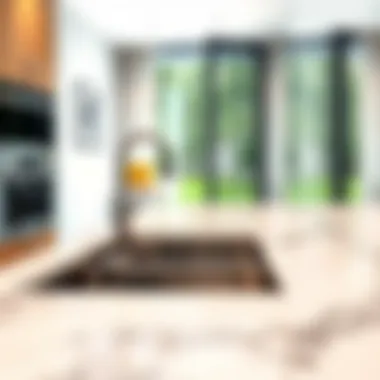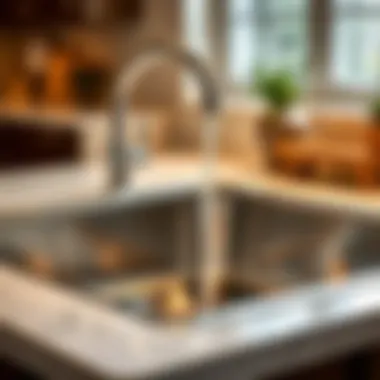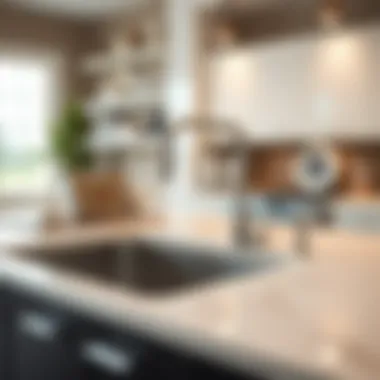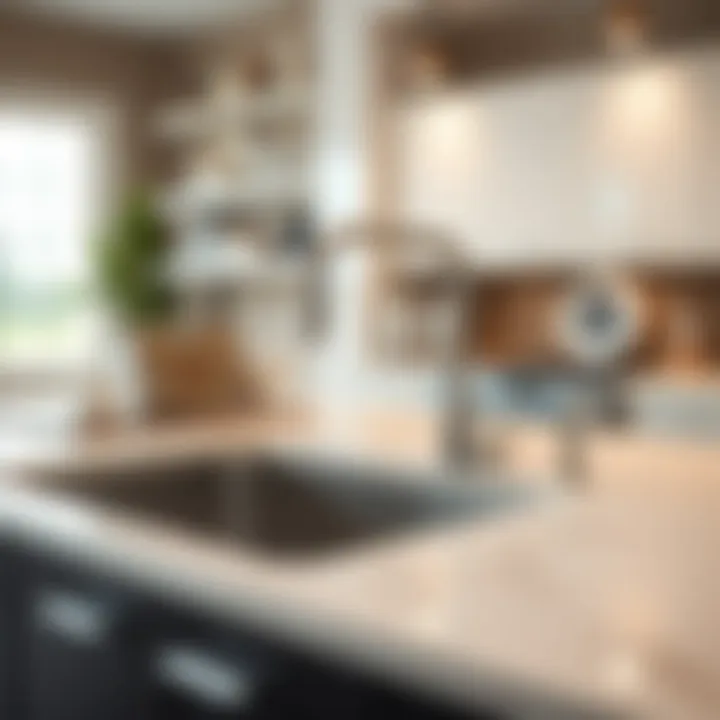Stainless Steel Sink and Countertop Combos Guide


Intro
Stainless steel sink and countertop combos have been gaining traction in kitchens everywhere, offering a blend of practicality and style. As homeowners look to create spaces that are not just functional but visually appealing, these combinations have stepped up to the plate. Great design should not compromise on usability, and stainless steel provides both. In this guide, we'll explore the numerous advantages these combos can offer, from their durability to their sleek, modern appearance, while also considering the potential pitfalls. Understanding how they integrate with various kitchen designs and how to maintain them is crucial for anyone looking to elevate their culinary environment.
Furniture Design Insights
Understanding Style Preferences
When it comes to kitchen design, choosing the right style can set the tone for the entire space. Stainless steel sinks and countertops come in a range of finishes that can either complement a warm, rustic kitchen or enhance the sleek lines of a contemporary setup. The brushed finish often appears more subdued and may blend well with matte cabinetry, while polished finishes can create a striking contrast against darker tones.
There are several styles to consider:
- Modern: Clean lines and minimalistic features. Perfect for open-concept areas.
- Industrial: Raw finishes and exposed elements, pairing well with brick walls or metal accents.
- Traditional: Classic designs with ornately detailed fixtures. Integrating antique cabinetry can provide balance to the shiny metal surfaces.
Consider your overall vision. Are you aiming for an inviting nook or a high-energy food prep zone? Matching these aesthetics with your countertop and sink combo is essential for cohesion.
Maximizing Space with Smart Layouts
Space management in kitchens is often about finding that sweet spot between efficiency and comfort. Stainless steel sink and countertop combos can play a pivotal role in making the most of your available area. Utilizing corner units with integrated sinks can not only save space but also dramatically enhance the look of your kitchen. Here are some layout ideas to consider:
- L-Shaped Layout: Ideal for smaller kitchens where maximizing corner space is key. A corner sink can be the focal point yet remain unobtrusive.
- Peninsula Design: This style allows for an informal dining area while providing ample workspace. Incorporate a sink in the peninsula for easy access.
- Galley Kitchen: A long, narrow layout that works beautifully with stainless fixtures. Here, you can create a streamlined workspace that moves seamlessly from preparation to cleaning.
Effective space management can lead to a more enjoyable cooking experience, allowing the kitchen to flow effortlessly while reducing clutter.
Maintenance and Care Tips
Cleaning Techniques for Different Materials
Maintaining a stainless steel sink and countertop combo doesn’t have to be a headache. Regular upkeep ensures the surfaces remain looking new for years. The key is knowing the right cleaning methods. For general upkeep:
- Use a soft cloth or sponge with warm water and a mild soap to wipe surfaces.
- For tougher stains or discoloration, a paste of baking soda and water can work wonders without scratching the metal.
- Rinse thoroughly with water and dry immediately to prevent water spots.
Avoid abrasive cleaners, as these can leave scratches that mar the shiny surface.
Preventative Measures Against Wear and Tear
To keep your combo in peak condition, consider these preventative tips:
- Use Cutting Boards: Protect countertops from scratches and nicks by using a cutting board whenever chopping or preparing food.
- Coasters and Mats: Place mats under pots and pans to prevent damage from hot items.
- Regular Deep Cleaning: Every few weeks, do a deep cleaning with a specialized stainless steel cleaner to maintain that luster.
"With regular care, stainless steel sinks and countertops can remain a staple in modern kitchens for years to come."
Maintaining your stainless steel features may seem daunting, but with proactive steps, it can be straightforward and rewarding. By ensuring they stay clean and well-protected, you can preserve the aesthetic and functional aspects that make these combos so appealing.
Epilogue
Ultimately, choosing a stainless steel sink and countertop combo can transform a kitchen into a functional artwork. With an understanding of design principles, maintenance strategies, and layout optimization, even a novice decorator can achieve an extraordinary look. Remember, these combos represent a commitment to durability and style, promising an investment that serves both utility and elegance. For further reading and tips, check out resources from Home and Garden or The Spruce.
Understanding Stainless Steel Sinks
In any modern kitchen, stainless steel sinks stand as a staple, embodying both practicality and elegance. Recognizing their significance is essential, especially when considering how they integrate seamlessly with countertops to heighten the overall aesthetic and functionality of the space. These sinks are not just utilitarian; they serve as the central focus in a kitchen, providing a blend of durability and style that appeals to designers, homeowners, and DIY enthusiasts alike.
Properties of Stainless Steel
The properties of stainless steel are hallmark features that distinguish these sinks from other materials. Composed primarily of iron, carbon, and chromium, it exhibits excellent resistance to rust and corrosion. This corrosion resistance is crucial in a kitchen environment, where moisture and spills are daily occurrences.
Moreover, stainless steel is relatively lightweight compared to other materials, making it easier to handle during installation and user-friendly for moving pots and pans. The alloy also offers a sleek look that fits any design aesthetic, from ultra-modern to traditional. Users can appreciate these sinks knowing they’re built to withstand the rough-and-tumble of daily life while remaining visually appealing.
Types of Stainless Steel Sinks
When considering stainless steel sinks, understanding the various types is key. Each has unique characteristics that cater to different needs and tastes.
Top Mount Sinks
Top mount sinks, also known as drop-in sinks, are installed above the countertop. This style is easy to install, making it a popular option among DIYers. The most notable characteristic is their visible rim, which can be beneficial in that it creates a barrier to liquids spilling over, keeping the countertop dry. However, this same feature can harbor grime if not cleaned regularly. Their straightforward installation process and lower cost contribute significantly to their appearance in homes across the globe.
Under Mount Sinks
On the flip side, under mount sinks are fastened beneath the countertop. This design offers a more streamlined appearance, allowing for easy cleanup as crumbs and spills can be wiped directly into the sink. Its compatibility with contemporary materials makes it particularly appealing in modern kitchen designs. However, it's important to note that these may require a bit more effort during installation, needing careful alignment and sometimes support from professional installers. Overall, if you’re looking to enhance the sleekness of your kitchen while promoting practicality, under mount sinks are definitely worth considering.
Single Bowl vs. Double Bowl
The choice between single and double bowl sinks is pivotal in kitchen design, impacting usability. Single bowl sinks offer expansive space, allowing for larger pots and pans to fit without hassle. This characteristic is advantageous for cooking enthusiasts or larger families. Yet, they can present challenges when multitasking, such as washing dishes while rinsing vegetables.
On the other hand, double bowl sinks create a division that permits simultaneous tasks, making them useful for meal prepping or washing dishes as you rinse off produce. However, it’s worth mentioning that the divided space can limit the size of items washed, which can be an inconvenience for some.


Benefits of Stainless Steel Sinks
Delving into the advantages of stainless steel sinks illuminates why these fixtures are favored choices for kitchens.
Durability and Longevity
A standout aspect of stainless steel sinks is their incredible durability. They are resistant to chipping, cracking, and discoloration. Unlike other materials which may wear down or show signs of age, stainless steel maintains its appearance over years of use. This inherent toughness can lead to investment savings in the long run, as replacements are far less frequent.
Resistance to Stains and Odors
Stainless steel sinks boast a smooth surface that inhibits bacterial growth while resisting stains and odors. This quality is especially vital in kitchens where raw food is often processed. The nonporous nature means spills won’t set in, ensuring a clean, hygienic space. Homeowners can breathe easy knowing that their kitchen fixtures won’t harbor unwanted smells or the risk of lingering bacteria, promoting a healthier cooking environment.
Versatility in Design
Lastly, the versatility of stainless steel sinks cannot be overstated. They come in various styles, sizes, and finishes to fit multiple kitchen designs. Whether you lean towards a minimalist aesthetic or appreciate a more traditional look, there’s likely an option that seamlessly blends.
Their flexibility further extends to integration with different countertop surfaces, providing the perfect balance in not just features but overall kitchen design. Incorporating a stainless steel sink conveys a sense of modernity and function, a combination every designer or homeowner seeks.
In summary, understanding stainless steel sinks, their types, and benefits highlights their significance in achieving an efficient and aesthetically pleasing kitchen layout. Their attributes align closely with current trends in kitchen design, promoting both functionality and style.
The Role of Countertops in Kitchen Design
In any kitchen, countertops serve more than just a practical purpose. They play a crucial role in the overall design and functionality of the space. Countertops not only need to withstand the daily hustle and bustle of a kitchen – from food prep to entertaining guests – but they must also meld seamlessly with the style and ambiance of the home. The right countertop can elevate the kitchen's aesthetic, providing both beauty and utility.
Material Options for Countertops
The selection of countertop materials is vast. To narrow it down, let's take a look at three popular choices: natural stone, quartz, and laminate. Each of these countertop materials brings its own set of characteristics that contribute to kitchen design.
Natural Stone
Natural stone countertops, such as granite or marble, are renowned for their unique beauty and durability. The distinct veining and colors found in each slab ensure no two pieces are alike, adding a touch of elegance that enhances a kitchen’s appeal. One could argue that their luxurious feel makes them a favorite among homeowners aiming for high-end designs.
However, maintenance can be a double-edged sword. While durable, natural stone may be susceptible to stains and require sealing periodically to maintain its surface. So, if you fancy a pristine look but can't commit to upkeep, this could be a consideration.
Quartz
Quartz countertops, man-made from a blend of natural quartz crystals and resin, are gaining popularity for good reasons. This material boasts impressive durability and resistance to stains and scratches. Plus, the range of colors and patterns available means you can find the perfect match for your kitchen design.
One of the key features of quartz is its non-porous nature, making it low-maintenance—a big win for busy cooks. Conversely, high temperatures can cause damage, so using trivets is advised. Overall, quartz tends to be a practical and aesthetic choice for many homeowners.
Laminate
Laminate countertops offer an economical solution for those on a budget. They come in a multitude of colors and patterns, providing ample opportunity for creative expression in the kitchen. A laminate surface can mimic materials like wood or stone without the associated costs.
Despite their affordability, laminate lacks the durability of stone or quartz. They are prone to scratching and heat damage, which may not sit well with avid cooks. Yet, for those who prioritize cost-effectiveness and a versatile appearance, laminate can still do a decent job.
Comparing Countertop Material Properties
When considering which countertop material to choose, comparing their properties becomes essential. Highlights include durability, maintenance, and cost considerations—all of which shape the decision-making process for kitchen remodels.
Durability
Durability is paramount in the kitchen environment. It encompasses how well the material can withstand daily use. Natural stones are robust but can chip and crack. Quartz shines here with its ability to endure heavy use without major signs of wear, whereas laminate can wear down quickly in high-traffic areas.
Maintenance Requirements
Maintenance requirements differ considerably among materials. Natural stone needs regular sealing, quartz requires occasional cleaning, and laminate is the easiest to maintain but has limitations in terms of longevity. Understanding these aspects can guide homeowners in selecting based on their lifestyle needs.
Cost Considerations
Lastly, cost can greatly influence choices in countertop materials. Natural stone typically carries a higher price tag compared to quartz and laminate. Homeowners need to factor in their budget but should also consider long-term investment returns concerning durability and appearance.
Stylish Combinations with Stainless Steel
Combining countertops with stainless steel sinks can yield stunning results. The interaction of different materials can create a harmonious kitchen environment that bursts with flair.
Contrasting Textures
Contrasting textures can elevate a kitchen's aesthetic, making it fresh and visually interesting. For example, pairing sleek stainless steel with rustic wood countertops can strike an enticing balance between modern and traditional design elements.
Color Synchronization
Color synchronization involves choosing colors that complement one another rather than clash. For instance, a rich, warm-toned countertop can soften the stark nature of stainless steel, leading to a cohesive kitchen palette. This thoughtful approach not only unifies the space but also offers a more inviting ambience.
Modern vs. Traditional Aesthetics
Finally, the choice between modern and traditional aesthetics can shape the style of the entire kitchen. Modern designs lean toward minimalism and clean lines, often featuring stainless steel and engineered stones like quartz. Traditional styles, on the other hand, may embrace warmth through natural materials like wood and stone, often providing a hearty feel. Homeowners must reflect on which aesthetic resonates with their vision for their kitchen layout.


The choice of countertops plays a significant role in the overall design and functionality of a kitchen. Understanding the various materials available, their properties, and how they can complement stainless steel can lead to a space that is both beautiful and practical.
Installation Considerations for Sink and Counter Combo
When it comes to enhancing your kitchen space, how you install a stainless steel sink and countertop combo can make all the difference. A flawless installation not only elevates aesthetics but also ensures functionality in daily use. Everything from the space available in your kitchen to the merging of style and practicality comes into play here. So, let’s break down the essential considerations for achieving a harmonious sink and countertop relationship.
Measurement and Planning
Assessing Available Space
The first step in any installation is hitting the ground running with assessing the available space. This part is crucial because a well-planned layout can prevent headaches down the line. Not only do you want to make sure your sink fits snugly into your countertop, but you also need to consider the workflow of your kitchen. When you measure your space carefully, you identify how much area you have to work with, which in turn contributes to optimizing the kitchen layout. Lack of space or poor measurements can lead to impractical choices, leaving you with an awkward setup that hinders daily cooking tasks. More often than not, folks overlook this detail, only to face an uphill battle with adjustments post-installation.
The key element here is customization—the ability to adapt your measurements to fit actual usage patterns. There's a unique advantage in tailoring your sink choice to your daily kitchen experience. It’s about compatibility, and making sure that your essential kitchen elements harmonize well.
Aligning Design with Functionality
Next on the docket is aligning design with functionality. In simpler terms, just because something looks good doesn't mean it works well. Considering how the design vibes with the overall functionality of your kitchen is paramount. This alignment helps create a seamless cooking environment where you can maneuver with ease.
One key characteristic of this alignment is the selection of the right materials and shapes. For example, if your kitchen is compact, a corner sink might be an artistic choice that also frees up counter space for prep work. This aspect of design is beneficial because it promotes a cohesive look, where aesthetics doesn't outshine practicality. The unique feature of aligning design with functionality ensures that your space is not only pleasing to the eye, but also serves its purpose efficiently—dinner preparation doesn’t become a juggling act, thanks to considered layouts.
Professional vs. DIY Installation
Now, let’s dive into the age-old debate: should you hire a pro or go the DIY route? Each option has its own set of merits, just waiting to be unpacked.
Benefits of Hiring Experts
When hiring installation experts, you reap rewards that often overshadow the initial costs. Expertise and experience can transform a daunting task into a smooth process. Professionals tend to have encountered a myriad of issues that arise during installs, allowing them to troubleshoot on the fly. This level of confidence means they can address potential complications before they morph into significant problems.
Not to mention, using seasoned installers minimizes the risk of mishaps—like unintentional water leaks or poor fitting that could haunt you later. This is particularly relevant in larger projects where precision holds utmost importance.
Steps for DIY Installation
If you lean toward a DIY installation, you’ll face a different set of challenges. Following a clear step-by-step process is vital to ensure success. Preparation is king here; you’ll need to gather your materials, tools, and a comprehensive understanding of your chosen sink and countertop.
The steps typically encompass:
- Measuring Your Space: As discussed, get it right at the start.
- Gathering Tools & Materials: You don’t want to be caught short without what you need.
- Preparing the Countertop: Ensure the surface is level and clean before you ever set the sink into place.
- Installing the Sink: Follow the manufacturer's instructions to avoid common pitfalls.
- Finalizing the Fitting: Check for leaks and make necessary adjustments.
While going DIY can be fulfilling, it often comes hand in hand with errors and unexpected hurdles unless you're adept at such work. Like anything, balance your skill set with the tasks at hand to decide the best route for achieving that perfect sink and countertop combo. The right choice ultimately leads to a kitchen that not only looks sharp but also performs beautifully for years to come.
Maintenance and Care for Stainless Steel Combos
Maintaining and caring for stainless steel sink and countertop combinations is pivotal in preserving their aesthetic appeal and functionality. These combos are not just practical enhancements to a kitchen; they embody a marriage of utility and style. Regular maintenance ensures they remain visually pleasing and prevents minor issues from escalating into costly repairs.
With proper care, your stainless steel setup can serve you for years, resisting wear and tear that may otherwise degrade its appearance. Here, we’ll delve into the essential cleaning techniques and damage prevention strategies specifically tailored for these materials.
Routine Cleaning Techniques
Regular cleaning forms the backbone of maintaining stainless steel sinks and countertops. Fortunately, the maintenance routine for these materials is quite straightforward. Here are a few key practices to keep in mind:
- Use Warm, Soapy Water: This is the easiest method. A mix of warm water with a few drops of mild dish soap can effectively lift grime.
- Soft Cloths or Sponges: Always opt for soft clothing or non-abrasive sponges to avoid scratches. A rough cloth can leave micro-abrasions.
- Rinse and Dry: Rinsing with clean water after washing is crucial. Water spots are common on stainless surfaces, and drying them immediately helps prevent this.
- Specialty Cleaners: Occasionally, you might want to use a cleaner designed specifically for stainless steel. These can provide a more polished finish without the risk of damage.
Implementing these routine cleaning techniques will keep your stainless steel combinations sparkling and functional.
Avoiding Common Damage
The Importance of Non-Abrasive Cleaners
Using non-abrasive cleaners is absolutely essential in preventing damage to stainless steel. Many people might not realize that common cleaning products often contain materials that scratch or stain the surface. Non-abrasive cleaners, characterized by their gentle formulation, do not contain any harsh particles. This makes them a favored choice for maintaining quality finishes.
Maintaining the integrity of your stainless steel finishes allows your sink and countertop to shine without unsightly marks. These cleaners typically boost the surface's natural luster, keeping your kitchen looking its best.
Scratches and Dents: Prevention Strategies
Preventing scratches and dents on your stainless steel sink and countertops is crucial. The key approach here is to be mindful of how you treat these surfaces. Employing protective mats or cutting boards when preparing food helps maintain the integrity of the surfaces. It's easy to forget how swiftly metal can become marred when subjected to sharp objects or heavy pots and pans.
Regularly assessing your kitchen tools and ensuring they are in good condition prevents accidental scratches. For instance, using a dull knife can create more friction and accidental damage compared to a sharp one. Many users find that investing in heavy-duty cutting boards provides a buffer, preserving the surface beneath.
Understanding these aspects of maintenance will help you maintain functionality while ensuring the longevity of your stainless steel combinations.
Evaluating Cost Factors
When diving into the realm of kitchen renovations, especially focusing on stainless steel sink and countertop combinations, evaluating cost factors can’t be overstated. This segment serves as the foundation for making sound decisions that align with both your aesthetic desires and budget constraints. Understanding these cost elements helps to streamline choices while ensuring you don’t bite off more than you can chew.
A multitude of factors, from material expenses to installation costs, can have a significant effect on your overall budget. Knowing exactly where your money goes and what each element contributes to your project sets the groundwork for a successful design.


Budgeting for Your Project
Material Costs Breakdown
Material costs form the backbone of your kitchen project budget. Breakdown those numbers, and you’ll see how they guide your overall approach. Stainless steel sinks and countertops are known for their durability; however, the varieties available can impact costs significantly. The price can vary based on the thickness of the steel, its grade, and any special finishes. Choosing a thicker steel might raise the initial cost but could save you money in the long run due to its longevity.
- Key characteristic: The strength and quality of the material specific to manufacturing.
- Why it's beneficial: Investing in high-grade stainless steel means fewer replacements in the future.
- Unique feature: Different grades like 304 and 316 stainless can have varying price points but offer distinct advantages, particularly in resistance to corrosion.
The higher the grade, the more resistant to damages it is, ultimately translating into savings on maintenance.
Installation Expenses
When it comes to installation, expenses can sneak up and catch you off guard if not planned for properly. Whether engaging professionals or opting for a DIY approach, knowing what lies ahead regarding costs allows for a smoother financial experience. Installation expenses might include the labor involved in fitting sinks and countertops, as well as costs associated with tools and materials if you're taking the DIY route.
- Key characteristic: Labor-intensive tasks related to sink placement and ensuring countertops fit securely.
- Why it's a popular choice: Many homeowners prefer to leave it to the experts, sparing them from potential mishaps and ensuring a quality finish.
- Unique feature: Whether hiring pros or doing it yourself, mistakes during installation could lead to increased costs, making initial estimates essential.
Potential Return on Investment
Market Trends
Staying attuned to market trends surrounding kitchen designs is crucial when considering your stainless steel combo. Money isn’t just spent; it’s also an investment in your home. Current trends show that modern buyers remain interested in quality materials like stainless steel due to their aesthetic appeal and practicality. In terms of resale value, a kitchen featuring a stainless steel setup can be quite attractive to potential buyers.
- Key characteristic: The growing interest in open-concept designs and multifunctional spaces placing emphasis on kitchen utility.
- Why it’s beneficial: Ensure your kitchen remains not just trendy but in demand should you decide to sell.
- Unique feature: Incorporating desirable features can lead to a pricing edge in competitive markets.
Value-Added Features
When assessing value-added features, consider what may boost the overall appeal and functionality of your setup. Features like integrated sinks with built-in accessories or smart faucets can dramatically enhance kitchen experience and efficiency.
- Key characteristic: Innovative designs that promote storage, organization, and water efficiency.
- Why it's a favorable choice: They not only improve the cooking and cleaning experience, but they can also raise your property value significantly.
- Unique feature: Some of these features may seem like splurges, but they can quickly pay for themselves through improved utility and attractiveness to prospective buyers.
"Don't just think about the upfront costs; consider the long-term value of your investment in a stainless steel sink and countertop combo."
Recent Trends in Kitchen Design
In recent years, there’s been a noticeable shift in the way people approach kitchen layouts and aesthetics. This change stems from a growing awareness of both functionality and visual appeal. Stainless steel sink and countertop combos have come to the forefront of these trends, combining practicality with an air of sleek elegance. By embracing these combinations, homeowners are not just upgrading their kitchens, but are connecting with a larger movement focused on sustainability, innovative design features, and adaptability to modern living.
Innovations in Sink Design
The kitchen sink is no longer just a utility fixture; it's becoming a focal point of modern kitchen design. Innovations in sink design have introduced features that redefine functionality. For instance, some sinks now come with built-in cutting boards and drainboards, allowing for a seamless food prep experience without clutter. Another exciting trend is the integration of smart technology, like sensors that automatically turn water on and off. These updates not only boost efficiency but also enhance the overall user experience.
Beyond mere utility, these sink innovations enable homeowners to express their personal style as well. Colors, finishes, and designs are becoming more diverse. Matte black and brushed gold finishes are becoming increasingly popular, giving kitchens a contemporary edge that stands out.
Sustainable Materials and Practices
As consumers grow more environmentally conscious, the focus on sustainable materials and practices is rising, influencing countless design decisions in the kitchen. This is where the convergence of functionality, aesthetics, and environmental responsibility is at its most pronounced.
Eco-Friendly Countertops
Eco-friendly countertops are an intriguing aspect of this trend. Made from recycled materials or sustainable sources, these surfaces offer a green alternative without sacrificing quality or beauty. Key characteristics of eco-friendly countertops include their durability and low chemical emissions, making them a smart pick for those looking to reduce their carbon footprint. Moreover, many of these products boast unique features such as heat resistance and stain resistance, providing longevity that traditional options sometimes lack.
While eco-friendly choices can be pricier initially, the long-term benefits, including lasting performance and the reduction of environmental impact, more than justify the investment. They represent a shift toward a more responsible style of living while also incorporating beauty and modern design into the kitchen.
Water Conservation Features
Water conservation features are also gaining importance in kitchen design, especially as awareness about resource management grows. These features often include specialized faucets that reduce water flow without compromising performance. Many designs now come with touchless sensors and ergonomically friendly handles that help to minimize water waste.
One distinguishing characteristic of these water conservation features is their ability to blend style with purpose. They are an attractive addition to modern kitchens, becoming stylish accents rather than mere utilitarian objects. This trend not only highlights an eco-conscious lifestyle but also serves as a practical solution to managing water usage effectively in everyday life.
When considering a stainless steel sink and countertop combo, incorporating eco-friendly materials and water-saving technologies can provide tangible benefits—reducing the impact on the environment while elevating the kitchen’s style and functionality.
"Sustainability in design is more than just a trend; it's a commitment to future generations. By choosing eco-friendly materials, we take a significant step towards responsible living."
By pulling together these elements—creative sink design, sustainable countertops, and water conservation—it’s clear that the recent trends in kitchen design are not just about aesthetics. They’re about making informed choices that resonate with the values of today’s consumers.
Culmination
In wrapping up our examination of stainless steel sink and countertop combinations, it’s essential to reflect on the factors that drive the choice of such units in kitchen design. Homeowners, designers, and retailers all must weigh the practical benefits against potential drawbacks.
Weighing the Benefits and Drawbacks
When thinking about incorporating stainless steel sink and countertop combos, it’s clear there are strong points and a few considerations to keep in mind. On the one hand, durability stands out as a cornerstone of stainless steel. Compared to more fragile materials like ceramic or granite, stainless provides a tough, long-lasting solution that can withstand the daily wear and tear of a bustling kitchen. Add to that its easy-clean nature, a big plus for those of us who want to maintain a neat space.
However, shiny surfaces can show scratches more visibly than other materials. Over time, maintaining that pristine look may require more diligent effort. Buyers should also consider the noise factor—pots and pans can clatter quite a bit on metal surfaces.
"A counter's material can make or break the kitchen experience. Don't just think about looks; think about the vibes too."
That said, when working out how stainless steel behaves with heat, it’s worth noting that it’s quite resistant, and that's a reassurance for any home cook. For those who prefer a modern aesthetic, it's hard to overlook the sleek, professional look that stainless steel delivers—ideal for a kitchen that aims for contemporary sophistication.
Final Thoughts on Selection
Selecting the right sink and countertop combination involves understanding not only personal preferences but also the functional needs of the space. Asking questions such as how often the kitchen is used and for what types of cooking can guide you. This allows for selections that support daily operations while still providing an inviting area for family gatherings and entertaining guests.
Moreover, color and texture compatibility ought to be a priority. While stainless steel offers a neutral look, coordinating it with the countertop can enhance overall kitchen aesthetics. This means considering factors like your cabinet finishes and kitchen theme, whether it leans more toward minimalism or has a touch of rustic charm.















